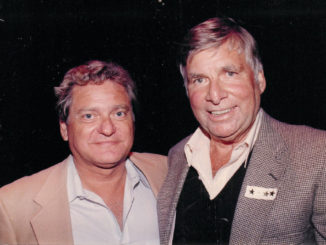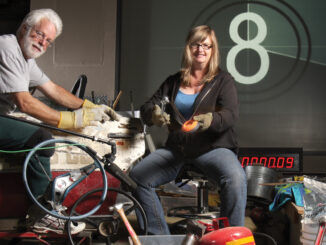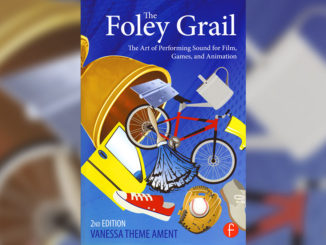
by Vince R. Gutierrez
A very summer, my family got invited to the Paramount Studio picnic by my uncle, Al Zuniga. New movie and TV stars would appear; most notably for me were the Cartwrights from Bonanza. Al was Paramount’s trailer editor and his job really intrigued me. I decided that film editing was my goal, so I would spend days in Al’s cutting room learning about everything from 35mm film stock to synching sound––and the infamous way to find the emulsion side of film by using the “lip test.”
In 1964, the union roster was low enough for me to get hired at Paramount, starting in film shipping. Al’s mentoring had paid off and I was on my way. It was awesome to walk around the lot and actually see John Wayne, Kirk Douglas, Dean Martin, Jerry Lewis, Steve McQueen, Ann- Margaret and Elvis Presley in the flesh.
After my Vietnam-era stint in the Army, I returned to Paramount and joined the NBC editorial staff as an apprentice, working exclusively on Bonanza and The High Chaparral. The next season, I had a chance to move into sound editing, specifically ADR––called “looping” in those days. Since it was a $50 bump in pay and I was a newlywed, the choice was pretty easy. Using 35mm sound loops, I spliced each line individually with leader in between. The actor would hear the line, then repeat it until we got a close match. Thousands of feet of film were recorded and, of course, all had to be edited.
Before digital editing, the final sound- track for television or features was accomplished using dozens of sound-edited reels of effects, dialogue and music––all synchronized to the 1,000-foot picture reels; six picture reels for an hour show, ten or more for a feature. A reel could hold from 15 to 30 units, all loaded onto reproducers in the dubbing channel and linked to the mixing board on the stage. Mastering was on three-channel 35mm full-coat mag masters, and voice was slated each time a new take was done. Needless to say, mixers had to be on their game and cue sheets were key. Since the mixing process was obviously tedious, ping-pong tables became the vogue on stages around town. You could actually get in two or three games while units were rewound or reloaded.
In the 1970s, an innovative post-production audio editing process, the PAP system, was developed by Joe Kelly, Rick Larson and Bill Wistrom at Glen Glenn Sound. It utilized video tape picture locked to film by time code and built dialogue and effects onto a two-inch, 24-track reel of tape. Sound editing was done by using quarter-inch dailies and tapes transferred from 35mm sound libraries instead of the normal film mag stripe sources. This innovation limited the number of film units needed, thereby pioneering the multi-track post audio era. Gone were the days of lugging hundreds of reels of film from stage to stage and doing thousands of butt splices.
In 1974, I became sound supervisor for Michael Landon on Little House on the Prairie, and our association lasted for over 17 years, spanning three successful series. Michael also became my second mentor by generously giving me a chance to write for Little House, Father Murphy and Highway to Heaven. It was incredibly gratifying to start with the written word and then follow the process until the final mix. Here I was creating shows alongside the same Little Joe Cartwright whom I had met at a studio picnic so many years before!
In 1991, I became general manager for Rick Larson and the Larson Sound Center, where I combined sound supervision with studio management. Television was our main clientele, with TV movies, drama series and sitcoms being the foundation of our success. Scott Millan and David Fluhr were part of our early team and both have gone on to be awarded Oscars and Emmys alike.
Historically, there was always a clear distinction made between feature sound editorial and TV sound editorial. Features had larger budgets, expansive post-production schedules and huge crews. Television was staffed leaner and had smaller budgets, yet was still expected to turn shows around every five or six days. Because of this, I believe TV helped innovate faster technology.
WaveFrame, Fairlight, and now ProTools have emerged from the TV editing rooms to be in every studio in town. Who would have thought we could edit an entire show, upload it to an FTP address and then download everything and mix without ever touching a single piece of film? New tools and plug-ins are created every day as our industry continues to grow, but it still boils down to our craft.
I’ve been honored with two Emmy Awards and currently serve as Sound Editing Governor with the TV Academy. Believe me, I understand what all of us do together to create the magic that is entertainment. So, let’s all enjoy it and pass the popcorn.





